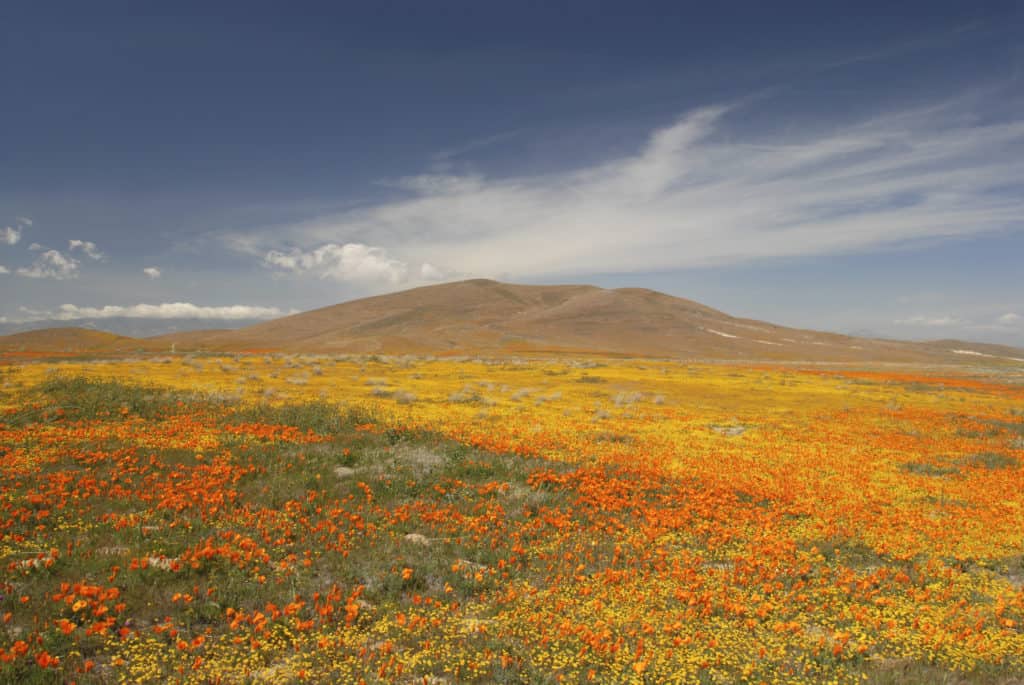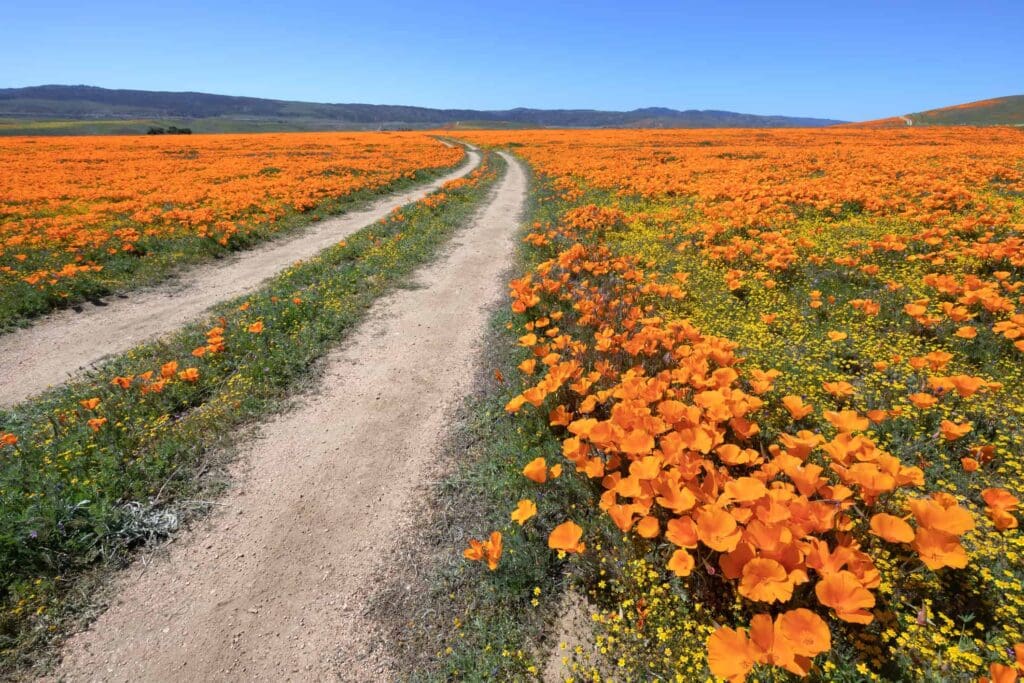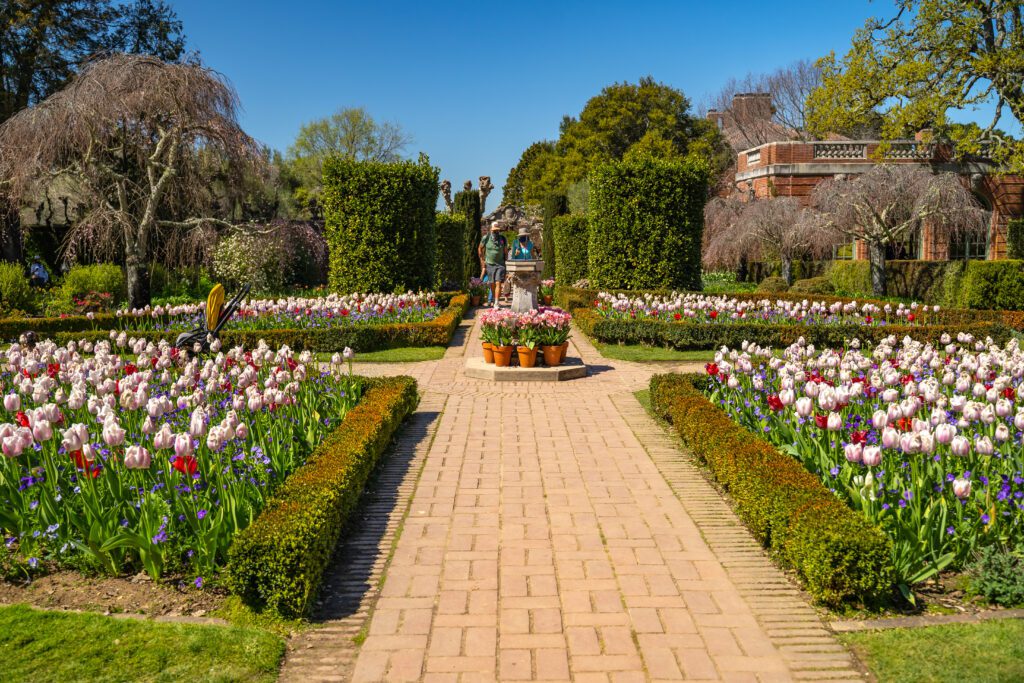Whenever a huge number of floral plants burst into bloom all at once in a single spot, you get an amazing, unforgettable scene. But the view is particularly awesome when the blossoms are bold and bright and emerge in an area that’s typically monochromatic. Such is the case during springtime in the Antelope Valley California Poppy Reserve, a State Natural Reserve that’s part of the Mojave Desert located in the remote far east corner of L.A. County.
During spring, thousands of wild California Poppies unfurl their vivid orange petals in response to the sunlight beaming down on the hills west of Lancaster, CA. Eye-popping doesn’t even begin to describe the vista, and once you see the stunning explosion of color, you’ll also understand why California named the poppy its official state flower. This beautiful wild perennial, also known as Golden Poppy and Flame Flower, grows along rural roads and freeways and is as much a symbol of the state as the gold that drew prospectors during the gold rush.
When to See the Poppies
The wildflower bloom typically takes place from mid-March through early May, though the time span and the intensity of the blooms’ colors vary according to weather conditions — significant rainfall that’s spread out over multiple storms is especially important. Peak bloom generally occurs in late March or early April.
If you’re making the trip specifically to see the flowers, be sure to check out the Poppy Reserve’s Facebook page for updates on the bloom status before venturing out. Or call the Poppy Reserve Wildflower Hotline at 661-724-1180. There’s also a live webcam that provides real-time views of the hills.
It’s best to visit on a sunny day in the midmorning when it’s warm enough for the poppies to open and wind-free enough for them to stay open; strong winds and clouds are not their friends and this area is known for powerful afternoon winds.
Where to Go in the Poppy Reserve to Get the Best Views

The first thing you should do when you arrive at the Poppy Reserve is stop by the Visitor Center, which opens in early March. The Reserve experts there are in the best position to tell you what spots will provide the best sightings—you should know that the top blooms are not always on the trails that most visitors tend to hike (the 3.3-mile South and North Loop trails, and the Tehachapi Vista Point). And fair warning: You’re going to be tempted to pick the beautiful blooms, but resist the urge, it’s against the law to collect anything in the Reserve without a permit. Just take pictures, lots and lots of pictures.
There’s lots of loveliness to explore at the Poppy Reserve beyond the poppy blooms. In spring, many other wildflowers, including lupine, cream cups and coreopsis, bloom in the desert grasslands and each provides its own unique fragrance and color (though none are as vivid as the poppies).
Eight miles of trails (there’s a paved section for wheelchair access) traverse gently rolling hills in the desert grassland habitat where visitors can spot wildlife, such as hawks and meadow larks, gopher snakes and, occasionally, coyotes and bobcats. The preserve also has great picnic areas with tranquil views of the San Gabriel Mountains.
More Colorful Parks to Visit Nearby in Springtime
The Day-Use entrance ticket you purchase to enter the Poppy Reserve also grants you entry to all other California State Parks that charge the same or lower price.
For more springtime wildflowers, head to Joshua Tree-filled Saddleback Butte State Park, located 32 miles east of the Poppy Preserve. The coreopsis that grows here also puts on quite the show of color, blanketing broad sections of the Mojave Desert in bright yellow hues punctuated by purple Davy gilia. The hiking trails will take you right through the blooms. For an easy hike from the visitor center, follow a 3-mile loop that combines the Little Butte Trail, Saddleback Butte Peak Trail and the unpaved park road.
To see brilliantly colored rocks, venture 60 miles north of the Poppy Reserve to Red Rock Canyon State Park, where the Sierra Nevada merges with the El Paso Range and desert cliffs. Buttes and rock formations broadcast vibrant red and pink tones. They are one of the reasons this park has been the site of hundreds of films.
And if those colors aren’t eye candy enough, look to the park’s springtime floral displays — all it takes for the awe-inspiring blooms to emerge is a wet fall and winter. Hikes on the miles of meandering trails in this park afford intimate exposure to its vast beauty — check with the visitor center to get advice on the wildflower viewing sites. You can expect to see the purples, yellows and golds of Mojave Aster, Monkey Flowers, Yellow Primrose, Indigo Bush and Desert Trump, among others.
Tip: California state parks’ guided nature hikes during the spring and fall are an excellent way to learn about the park wildflowers and other features. Check with the park visitor centers to learn about available options.






